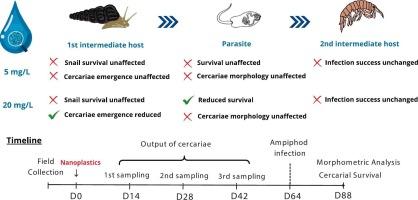塑料污染和寄生:纳米塑料对海洋吸虫寄生虫传播的影响
IF 8
1区 环境科学与生态学
Q1 ENVIRONMENTAL SCIENCES
引用次数: 0
摘要
限制寄生系统传播成功的因素仍然知之甚少,特别是在日益受人为干扰影响的海洋环境中。其中,海洋污染——全球变化的一个未得到充分认识和控制不足的组成部分——对生物多样性和生态相互作用构成了新的威胁。特别是,纳米塑料(NPs)这种普遍存在的生物活性污染物对宿主-寄生虫动力学的影响在很大程度上仍未被探索。本实验研究考察了NPs暴露对新新西兰吸虫的影响,新新西兰吸虫是一种具有复杂生命周期的寄生虫,包括蜗牛zeacmantus subcarinatus和片足类Paracalliope novizealandiae作为中间宿主。将感染的钉螺暴露于不同浓度的NPs(0、5和20 mg/L)中3个月。我们量化了蜗牛的尾蚴(自由游动感染阶段)的出现,评估了它们的存活率和对片脚类动物的传染性,并研究了对它们形态特征的影响。在20 mg/L的处理组中,仅在几周后就检测到子宫颈出现的显着减少,这表明高NP暴露具有延迟但累积的抑制作用。在20 mg/L浓度下,尾蚴存活率也显著降低,但在形态特征和对片脚类动物的传染性方面没有统计学差异。然而,高浓度时尾长减少的趋势可能反映了细微的功能损伤。虽然在短期接触下保持传染性,但尾蚴寿命的缩短可能限制了在自然环境中的传播机会。这些发现强调了在生态毒理学研究中纳入寄生虫传播评估的必要性,因为即使是轻微的破坏也可能通过食物网级联并影响生态系统的稳定性。本文章由计算机程序翻译,如有差异,请以英文原文为准。

Plastic pollution and parasitism: Impact of nanoplastics on the transmission of a marine trematode parasite
Factors constraining transmission success in parasitic systems remain poorly understood, especially in marine environments increasingly affected by anthropogenic disturbances. Among these, ocean pollution – an insufficiently recognized and inadequately controlled component of global change – poses emerging threats to biodiversity and ecological interactions. In particular, the impact of nanoplastics (NPs), pervasive and biologically active pollutants, on host–parasite dynamics remains largely unexplored. This experimental study examines the effects of NPs exposure on the trematode Maritrema novaezealandensis, a parasite with a complex life cycle involving the snail Zeacumantus subcarinatus and the amphipod Paracalliope novizealandiae as intermediate hosts. Infected snails were exposed for three months to different concentrations of NPs (0, 5, and 20 mg/L). We quantified cercarial (free-swimming infective stages) emergence from snails, assessed their survival and infectivity to amphipods, and investigated impacts on their morphological traits. A significant reduction in cercarial emergence was detected only after several weeks in the 20 mg/L treatment group, suggesting a delayed but cumulative inhibitory effect of high NP exposure. Cercarial survival was also significantly reduced at 20 mg/L, while no statistically significant differences were observed in morphological features or infectivity to amphipods. However, a trend toward reduced tail length at higher concentrations may reflect subtle functional impairments. While infectivity was maintained under short-term exposure, the reduced lifespan of cercariae may limit transmission opportunities in natural settings. These findings highlight the need to include assessment of parasite transmission in ecotoxicological research, as even minor disruptions can cascade through food webs and affect ecosystem stability.
求助全文
通过发布文献求助,成功后即可免费获取论文全文。
去求助
来源期刊

Science of the Total Environment
环境科学-环境科学
CiteScore
17.60
自引率
10.20%
发文量
8726
审稿时长
2.4 months
期刊介绍:
The Science of the Total Environment is an international journal dedicated to scientific research on the environment and its interaction with humanity. It covers a wide range of disciplines and seeks to publish innovative, hypothesis-driven, and impactful research that explores the entire environment, including the atmosphere, lithosphere, hydrosphere, biosphere, and anthroposphere.
The journal's updated Aims & Scope emphasizes the importance of interdisciplinary environmental research with broad impact. Priority is given to studies that advance fundamental understanding and explore the interconnectedness of multiple environmental spheres. Field studies are preferred, while laboratory experiments must demonstrate significant methodological advancements or mechanistic insights with direct relevance to the environment.
 求助内容:
求助内容: 应助结果提醒方式:
应助结果提醒方式:


